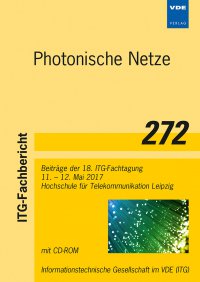Performance of Single- and Multi-Carrier Modulation with Additional Spectral Up-conversion for Wideband IM/DD Transmission
Conference: Photonische Netze - 18. ITG-Fachtagung
05/11/2017 - 05/12/2017 at Leipzig, Deutschland
Proceedings: Photonische Netze
Pages: 4Language: englishTyp: PDF
Personal VDE Members are entitled to a 10% discount on this title
Authors:
Kottke, Christoph; Schmidt, Christian (Fraunhofer Institute for Telecommunications, Heinrich-Hertz-Institute, Einsteinufer 37, 10587 Berlin, Germany & Technische Universität Berlin, Fachgebiet Hochfrequenztechnik, Einsteinufer 25, 10587 Berlin)
Habel, Kai; Jungnickel, Volker; Freund, Ronald (Fraunhofer Institute for Telecommunications, Heinrich-Hertz-Institute, Einsteinufer 37, 10587 Berlin, Germany)
Abstract:
The demand for high capacity transmission links in future optical networks is further increasing and requires the application of advanced modulation formats in combination with digital signal processing (DSP). For the necessary analog/digital conversion of these signals, high-speed and high-resolution DACs and ADCs are mandatory, which are not always commercially available. Furthermore, especially for short-range communication links with lengths of up to 20 km approximately, the use of low-cost optical components is a key requirement. In general, this results in the application of intensity modulation (IM) and direct detection (DD) schemes. This paper compares the performance of single- and multicarrier modulation formats with spectral up-conversion for wideband IM/DD transmission for data rates beyond 100 Gb/s. The generation of wideband signals is thereby not realized with a high-speed DAC, but instead with multiple lower speed DACs in combination with electrical upconversion. The resulting signal sub-bands are passively combined, thus enable a total signal bandwidth of up to 39 GHz. The achievable bandwidth corresponds to that of today’s high-end DACs. The optical link to experimentally validate the concept utilized of IM at the transmitter (Tx), DD at the receiver (Rx) and fiber lengths of up to 20 km. Different modulation formats like PAM, QAM, DMT and OFDM, together with standard digital signal processing were applied. We experimentally verify, that by utilizing different electrical sub-bands data rates of up to 180 Gb/s are achievable, with simple IM/DD schemes and without using the latest high-end DACs. Furthermore, the suitability of various modulation formats for different sub-bands is shown and the occurring penalties are investigated.


